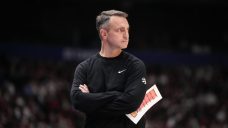TORONTO — It was late, there was no one else in the building and the player who had helped usher in the NBA’s ‘load management’ era was limping.
The only two people in the OVO Athletic Centre on a late spring evening in 2019 were Toronto Raptors president Masai Ujiri and Kawhi Leonard.
The Raptors were trailing the Milwaukee Bucks 2-1 in the Eastern Conference Finals. Leonard was a day removed from playing a career-high 52 minutes in the Raptors' double-overtime Game 3 win, which allowed them to stay alive in the best-of-seven series.
Heading into Game 4, Toronto was still very much on the ropes. Fall behind 3-1 and the Raptors would have to win three straight elimination games over the favoured Bucks to keep their championship hopes alive, two of them in Milwaukee. Even the series 2-2 and the momentum would swing in the Raptors' favour.
Despite the stakes Ujiri wanted to let Leonard, a pending free agent, know that he should take care of his health first. If he needed to rest his gimpy knee, it was understood.
Leonard, who has never used three words when two would do, simply said “I’m playing” and, after a long day of treatment at the Raptors facility, headed home into the Toronto night. The Raptors won Game 4 — though Leonard played one of his few 'average' games of his timeless post-season run in that one — and went on to win the Eastern Conference title over the Bucks in six games and push past the two-time defending champion Golden State Warriors for the title.
Leonard won Finals MVP. After missing 22 regular season games and all of the Raptors' back-to-back games, Leonard led the NBA in minutes in the post-season.
A Toronto legend was born, a parade ensued and the championship banner will hang forever.
It was also considered a banner year for sports science, as careful monitoring and preventative maintenance by the Raptors' medical staff successfully returned Leonard to peak form.
A few years later — and in the wake of Leonard’s success with 'load management' sweeping the league — the NBA is trying to argue that the data is in, and resting players doesn’t actually work.
"I think it was a given conclusion that the data showed that you had to rest players a certain amount and that justified guys sitting out," NBA executive vice president and head of basketball operations Joe Dumars said Wednesday during a conference call with national media. "We've gotten more data, and it just doesn't show that resting, sitting guys out, correlates with lack of injuries or fatigue or anything like that.
"What it does show is guys may be not as efficient on the second night of a back-to-back. But in terms of injury and things like that, that we thought that it did prior, as we got more data, we realized that's not really holding up."
The reason the league is making the push — or at least pushing back against the idea resting athletes is good for them — is that they are trying to avoid the potential impact on the bottom line.
While negotiating a new collective bargaining agreement with the players association, the league made sure to hit rest on what they viewed as a growing problem of star players sitting out too often with dubious injuries.
“We’re an 82-game league,” is the message.
Which isn’t the message the league took from the Raptors' championship season and Leonard’s remarkable run to Finals MVP. After Leonard proved he was able to carry a massive post-season burden a year removed from playing just nine regular-season games in his last year in San Antonio, the industry collectively embraced the idea that less may be more.
All across the NBA teams began sitting out star players as a matter of routine, either while being abundantly cautious in managing a return from injury or even in situations where the schedule was simply deemed to not allow for proper rest or recovery. In other words, stars were sitting out due to injuries that hadn’t happened yet.
The practice may have peaked last season as the 15 members of the three all-NBA teams played an average of 67 games. Fifteen years before that the 15 players on the all-NBA teams suited up for an average of 77 games.
And to be clear, it’s mostly an issue that affects stars. Role players don’t have the sway to manage aches and pains the way a superstar might.
“I play. I try to be available for every single game, which is probably the reason why I played over 1,000 of them,” Raptors veteran Thad Young, who is starting his 17th season, said Thursday. “So for me, it’s more so just me being available for my team. Like I can't really speak on any other franchise or any other organization or any of the players. But I'm going to be available for my team. If I'm fine, if I'm good to go, I'm gonna make sure I'm playing. I don't really care about the load management and the resting or anything like that. That's more so for teams and their star players to worry about, so I let them worry about that… I strive to play and be available for all 82-plus — playoffs, pre-season, whatever.”
Interestingly while Leonard is often cited as the inspiration for the NBA’s shift towards 'load management' he has made clear that it wasn’t new-fangled 'load management' but old-fashioned injury management that allowed him to get through his championship season in Toronto. As he said at the opening of training camp with the Los Angeles Clippers — and a year removed from missing a full season with an ACL tear — “I was hurt all season [in Toronto].”
The NBA has set out to make sure players — and teams — are clear about the importance of playing regularly scheduled games that they can have sold advertising for.
Beginning this season players will have to have played at least 65 games to qualify for any of its major end-of-season awards or all-league recognition. Since contract incentives are often tied to the awards, there should be an impact. As well, the league unveiled a new “player resting policy” which required that teams ensure ‘stars’ — players who have been an all-star in one of the previous three seasons — are available to play nationally televised games and in its new in-season tournament, while also encouraging games where ‘stars’ do sit out be balanced between home and road games.
Was there a problem? It’s hard not to argue it was becoming a bigger and bigger issue at least for TV viewers tuning in for big games or ticket buyers showing up to the arena hoping to see stars play only to have them sit out for precautionary reasons.
That the league wants that to change and is now citing 'inconclusive data' to help justify the shift is easy to understand if they aren’t sharing any of their 'data.' Some decimal points matter more than others. The league is in the process of negotiating what they hope will be a massive new media rights deal and those who will be paying billions to hype up games involving the league’s biggest names want some assurance that the stars will actually be playing.
Given media rights are the single largest revenue driver for a league that shares basketball-related revenue in a roughly even split with the players, it’s not all that surprising the players’ union signed off on it.
Interestingly, back in Toronto, 'load management' ceased to become a topic almost instantly after Leonard moved on to the Clippers in the summer of 2019.
For the past two seasons the Raptors — still with the same sports science team in place as when Leonard was making it through the 2018-19 season in one piece — have played their stars harder and longer than anyone. Pascal Siakam, the Raptors' best player, has led the NBA in minutes played per game each of the past two years.
The emphasis may change somewhat this season but not because of anything the league is doing. Incoming head coach Darko Rajakovic hopes to be able to manage the fatigue levels of his players by having a 10-man rotation. The minutes-per-game load for his key players may go down, but the hope is the number of games will stay constant.
“It’s a long season. We need to be smart,” said Rajakovic. “Obviously we want to play our best players in every game when we have the opportunity to do so. But at the same time, it is very important to play more than eight guys. I want to have 10 guys in the rotation so more players have less minutes per game and that way they can be more ready to play over the long season.”








COMMENTS
When submitting content, please abide by our submission guidelines, and avoid posting profanity, personal attacks or harassment. Should you violate our submissions guidelines, we reserve the right to remove your comments and block your account. Sportsnet reserves the right to close a story’s comment section at any time.